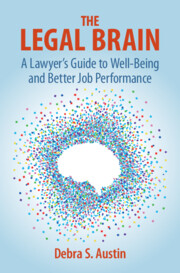Book contents
- The Legal Brain
- The Legal Brain
- Copyright page
- Dedication
- Contents
- Acknowledgments
- Introduction
- 1 The Impaired Lawyer
- 2 The Spectrum from Languishing to Flourishing
- 3 The Lawyering Culture
- 4 The Lawyer’s Brain
- 5 Memory, Knowledge, and Building Expertise
- 6 Motivation, Reward, and Developing Habits
- 7 The Impact of Stress
- 8 The Influence of Self-Medication
- 9 The Importance of Fuel
- 10 Optimizing Brain Health
- 11 Enhancing Mental Strength
- 12 Developing an Action Plan for the Neuro-intelligent Lawyer
- 13 The Neuro-intelligent Legal Organization
- Conclusion
- Select Bibliography
- Index
4 - The Lawyer’s Brain
Published online by Cambridge University Press: 08 May 2024
- The Legal Brain
- The Legal Brain
- Copyright page
- Dedication
- Contents
- Acknowledgments
- Introduction
- 1 The Impaired Lawyer
- 2 The Spectrum from Languishing to Flourishing
- 3 The Lawyering Culture
- 4 The Lawyer’s Brain
- 5 Memory, Knowledge, and Building Expertise
- 6 Motivation, Reward, and Developing Habits
- 7 The Impact of Stress
- 8 The Influence of Self-Medication
- 9 The Importance of Fuel
- 10 Optimizing Brain Health
- 11 Enhancing Mental Strength
- 12 Developing an Action Plan for the Neuro-intelligent Lawyer
- 13 The Neuro-intelligent Legal Organization
- Conclusion
- Select Bibliography
- Index
Summary
The brain has two superpowers: continuous development, which is the capacity to rewire itself with everything you think, learn, and do, called neuroplasticity; and neurogenesis, which is the birth of new brain cells in our memory-processing hippocampus. The brain has three functional areas: the primitive brain, the emotional brain, and the thinking brain. The emotional and thinking brains work together to help us learn and think and to develop our habits. Information flows throughout the brain, and from the brain to the body, via brain cells called neurons. Each lawyer’s brain has a unique network of brain cells because each of us leads different lives. Information is transmitted as an electrical impulse within the neuron, which shifts to a chemical messenger, called a neurotransmitter, to jump from neuron to neuron. The architecture of the thinking brain’s neural networks is called the connectome, and each brain is a work in progress for the entire lifespan. We can make choices that empower our brain, or decisions that harm our brain. With the right information, a lawyer can self-hack the brain to change its structure and function, improving its capabilities.
Keywords
- Type
- Chapter
- Information
- The Legal BrainA Lawyer's Guide to Well-Being and Better Job Performance, pp. 57 - 64Publisher: Cambridge University PressPrint publication year: 2024



